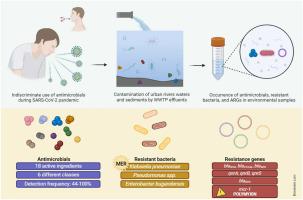当前位置:
X-MOL 学术
›
J. Hazard. Mater.
›
论文详情
Our official English website, www.x-mol.net, welcomes your feedback! (Note: you will need to create a separate account there.)
Emerging threat: Antimicrobial resistance proliferation during epidemics — A case study of the SARS-CoV-2 pandemic in South Brazil
Journal of Hazardous Materials ( IF 13.6 ) Pub Date : 2024-04-02 , DOI: 10.1016/j.jhazmat.2024.134202 Raizza Zorman Marques , Keite da Silva Nogueira , Ana Paula de Oliveira Tomaz , Philippe Juneau , Shanquan Wang , Marcelo Pedrosa Gomes
Journal of Hazardous Materials ( IF 13.6 ) Pub Date : 2024-04-02 , DOI: 10.1016/j.jhazmat.2024.134202 Raizza Zorman Marques , Keite da Silva Nogueira , Ana Paula de Oliveira Tomaz , Philippe Juneau , Shanquan Wang , Marcelo Pedrosa Gomes

|
The escalating global concern of antimicrobial resistance poses a significant challenge to public health. This study delved into the occurrence of resistant bacteria and antimicrobial resistance genes in the waters and sediments of urban rivers and correlated this emergence and the heightened use of antimicrobials during the COVID-19 pandemic. Isolating 45 antimicrobial-resistant bacteria across 11 different species, the study identifies prevalent resistance patterns, with ceftriaxone resistance observed in 18 isolates and ciprofloxacin resistance observed in 13 isolates. The detection of extended-spectrum β-lactamases, carbapenemases, and acquired quinolone resistance genes in all samples underscores the gravity of the situation. Comparison with a pre-pandemic study conducted in the same rivers in 2019 reveals the emergence of previously undetected new resistant species, and the noteworthy presence of new resistant species and alterations in resistance profiles among existing species. Notably, antimicrobial concentrations in rivers increased during the pandemic, contributing significantly to the scenario of antimicrobial resistance observed in these rivers. We underscore the substantial impact of heightened antimicrobial usage during epidemics, such as COVID-19, on resistance in urban rivers. It provides valuable insights into the complex dynamics of antimicrobial resistance in environmental settings and calls for comprehensive approaches to combat this pressing global health issue, safeguarding both public and environmental health.
中文翻译:

新出现的威胁:流行病期间抗生素耐药性扩散——巴西南部 SARS-CoV-2 大流行的案例研究
全球对抗菌素耐药性的日益关注给公共卫生带来了重大挑战。这项研究深入研究了城市河流的水域和沉积物中耐药细菌和抗菌药物耐药基因的出现情况,并将这种出现与 COVID-19 大流行期间抗菌药物的增加使用联系起来。该研究分离了 11 个不同物种的 45 种耐药细菌,确定了普遍的耐药模式,其中在 18 个分离株中观察到了头孢曲松耐药性,在 13 个分离株中观察到了环丙沙星耐药性。所有样本中检测到的超广谱 β-内酰胺酶、碳青霉烯酶和获得性喹诺酮抗性基因凸显了情况的严重性。与 2019 年在同一河流进行的大流行前研究的比较揭示了以前未检测到的新抗性物种的出现,以及值得注意的新抗性物种的存在和现有物种抗性谱的变化。值得注意的是,在大流行期间,河流中的抗菌药物浓度增加,极大地促进了这些河流中观察到的抗菌药物耐药性的发生。我们强调在 COVID-19 等流行病期间增加抗菌药物的使用对城市河流耐药性的重大影响。它为环境环境中抗菌素耐药性的复杂动态提供了宝贵的见解,并呼吁采取综合方法来应对这一紧迫的全球健康问题,维护公众和环境健康。
更新日期:2024-04-02
中文翻译:

新出现的威胁:流行病期间抗生素耐药性扩散——巴西南部 SARS-CoV-2 大流行的案例研究
全球对抗菌素耐药性的日益关注给公共卫生带来了重大挑战。这项研究深入研究了城市河流的水域和沉积物中耐药细菌和抗菌药物耐药基因的出现情况,并将这种出现与 COVID-19 大流行期间抗菌药物的增加使用联系起来。该研究分离了 11 个不同物种的 45 种耐药细菌,确定了普遍的耐药模式,其中在 18 个分离株中观察到了头孢曲松耐药性,在 13 个分离株中观察到了环丙沙星耐药性。所有样本中检测到的超广谱 β-内酰胺酶、碳青霉烯酶和获得性喹诺酮抗性基因凸显了情况的严重性。与 2019 年在同一河流进行的大流行前研究的比较揭示了以前未检测到的新抗性物种的出现,以及值得注意的新抗性物种的存在和现有物种抗性谱的变化。值得注意的是,在大流行期间,河流中的抗菌药物浓度增加,极大地促进了这些河流中观察到的抗菌药物耐药性的发生。我们强调在 COVID-19 等流行病期间增加抗菌药物的使用对城市河流耐药性的重大影响。它为环境环境中抗菌素耐药性的复杂动态提供了宝贵的见解,并呼吁采取综合方法来应对这一紧迫的全球健康问题,维护公众和环境健康。



























 京公网安备 11010802027423号
京公网安备 11010802027423号